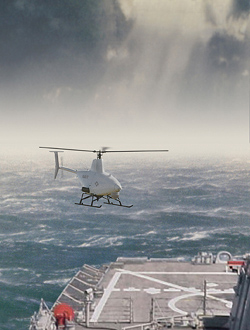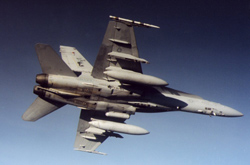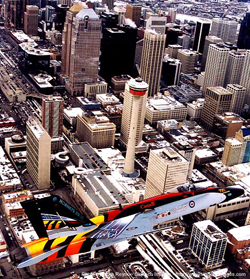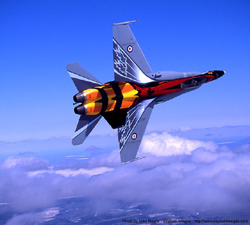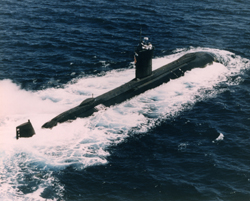Page 1
Daily News
By Gail Helmer
| Send Us News | Archives | Main |
Wednesday May 22, 2002
Military News
- Prototype Of Fire Scout UAV Completes First Flights
- First Production ATFLIR for US Navy Warfighters
- CF-18 Hornets Celebrate 20th Service Anniversary
- Crew of Sub Safely Evacuated After Fire, Flooding
Prototype Of Fire Scout UAV Completes First Flights
The third prototype of the U.S. Navy's RQ-8A Fire Scout vertical takeoff and landing tactical unmanned air vehicle system successfully completed its first two flights May 19, at Naval Air Warfare Center, Weapons Division, China Lake, Calif.
The Fire Scout system was designed by Northrop Grumman Corporation's Integrated Systems sector as a force multiplier for Navy forces at sea and Marine Corps forces ashore. The prototype unmanned aerial vehicle (UAV) is a technology demonstrator for the RQ-8A program.
These flights tested the system's ability to take off, fly and land autonomously. The first test, the shorter of the two, verified the ability to modify the system's fully autonomous, preprogrammed mission by executing override commands to hover and land. Following launch, the air vehicle climbed to 30 feet and began forward flight. Upon reaching 10 knots air speed, it was given a zero airspeed command, after which it entered a hover at 30 feet. It was given an override land command by the system operator and the vehicle landed on the runway centerline.
The five-minute second flight demonstrated a completely autonomous mission including vehicle start, takeoff, flight, landing and shutdown. Upon command, the vehicle launched and proceeded to hover at 30 feet at the first predesignated waypoint. The vehicle transitioned to forward flight at 10 knots, climbing to 100 feet. Three waypoints were crossed at 200 feet and 10 knots, respectively, while continuously correcting for a gusting, 90-degree crosswind. After capturing the final waypoint, the vehicle descended to a preprogrammed 30-foot hover/hold position. Following the land command, the vehicle landed on the runway centerline within inches of the intended touchdown point. The mission concluded with an autonomous shutdown.
The Fire Scout uses flight control architecture derived from Northrop Grumman's Global Hawk long-endurance, high-altitude reconnaissance system. Global Hawk has repeatedly demonstrated its ability to conduct autonomous missions of more than 30 hours' duration over thousands of miles. Another derivative architecture is on Northrop Grumman's X-47A Pegasus experimental vehicle, scheduled to fly later this year, which will demonstrate aerodynamic flying qualities for autonomous operation from an aircraft carrier. That demonstration will be used in Northrop Grumman's work on a naval unmanned combat air vehicle for the Defense Advanced Research Projects Agency and the Navy.
The Fire Scout system is in low-rate initial production for the Navy. Flying at altitudes up to 20,000 feet, the Fire Scout system employs an advanced payload with an electro-optical/infrared sensor including a laser designator/rangefinder to provide intelligence, reconnaissance and surveillance with pinpoint accuracy, giving military decision-makers real-time information and targeting of enemy resources and personnel on the ground. The Fire Scout's communications suite allows simultaneous voice/data relay much farther than the "line of sight" limits employed by current systems.
Fully autonomous, Fire Scout can fly high above deployed Marines to watch for threats within 150 nautical miles of the ground control station. The system then directs Navy and Marine weapons accurately to the target with precise target location coordinates or the laser designator. Fire Scout was designed to respond to Navy and Marine Corps emerging requirements and to replace the aging Pioneer. A complete system includes three UAVs, two ground control stations, a data link suite and modular mission payloads.
First Production ATFLIR for US Navy Warfighters
Raytheon Company delivered the first production ASQ-228 Advanced Targeting FLIR (ATFLIR) pod to the U.S. Navy May 21. This delivery marks the beginning of a multi-year plan to equip the Navy's F/A-18s with a third-generation infrared targeting system that is more capable, reliable and affordable than current systems.
"The F/A-18 with its ATFLIR will be the weapon delivery platform of choice, especially when it is important to differentiate a tank farm from a farm tractor, a troop carrier from a school bus, and an artillery emplacement from a decoy," said Rear Admiral James Godwin. "We are proud to have this marvelous weapon system in the fleet."
The U.S. Navy and Marine Corps are programmed to receive 574 pods with spares to equip their F/A-18 C/D and E/F aircraft. The ASQ-228 ATFLIR airborne targeting pod is scheduled to achieve early operational capability with the U.S. Navy's first F/A-18E squadron in June 2002.
The pod revolutionizes airborne fighter targeting with its combination of a targeting FLIR, based on a staring MWIR focal-plane array; a CCD television camera; and a high-power diode-pumped laser that has been demonstrated at altitudes of up to 50,000ft. In addition, a navigation FLIR is installed in the adapter that connects the pod to the aircraft. The ATFLIR combines the functions of three systems currently operational on the F/A-18, which creates space for an additional weapon on the aircraft.
Eight pods were delivered during the development phase. During more than 500 developmental test and operational test flights, the pods met or exceeded warfighter requirements for geopoint accuracy, laser designation and long-range target recognition. Furthermore, lifecycle costs are two-thirds of the current systems, with a higher mean time between failure and decreased time to repair.
The pods delivered yesterday will be initially used for technical evaluation and operational evaluation, and eventually for forward deployments within the next year. Operational evaluation on the ATFLIR is scheduled for October 2002. Initial operating capability for the U.S. Navy is planned for 2003.
CF-18 Hornets Celebrate 20th Service Anniversary
A specially-painted Canadian F/A-18 Hornet, or CF-18, has made a special trip to St. Louis in honor of the aircraft's 20 years of service in the Canadian air force.
"The Hornet is an exceptional aircraft for warfighting and aerial demonstrations," said Capt. Doug Clements, one of the pilots assigned to the Canadian Forces Hornet demonstration team. "The CF-18s we fly perform as well today as they did 20 years ago. And when it comes to handling characteristics, the Hornet just can't be beat."
CF-18 over Calgary, Alberta
The demonstration team will participate in a total of 18 air shows across North America this year -- seven in the United States and 11 in Canada. U.S. shows are scheduled in Davenport, Iowa; Rochester, N.Y.; Cleveland, Ohio, and Salinas, Calif. Although the team is not performing in St. Louis, the aircraft will be displayed on the Boeing [NYSE: BA] flight ramp the morning of May 21.
The aircraft bears a yellow, black and orange paint scheme designed to make it resemble an actual hornet. The paint scheme also incorporates a tribute to people who died in terrorist attacks on the United States on Sept. 11, 2001.
Canada was the first international customer for the F/A-18, and its fleet of 138 Hornets is the largest outside the United States. CF-18s operate out of Canadian Forces Base Cold Lake, Alberta, and Canadian Forces Base Bagotville. The first CF-18B, a two-seat model of the Hornet, was delivered on Oct. 26, 1982, to Canadian Forces 410 Squadron at Cold Lake. The squadron has accumulated more than 100,000 flight hours and trained almost 600 pilots in CF-18s.(Photography by Mike Reyno)
Crew of Research Sub Safely Evacuated After Fire, Flooding
The U.S. Navy diesel-powered research submarine USS Dolphin (AGSS 555) reported fire and flooding at 11:30 p.m. (PDT) Tuesday, May 21, while operating approximately 100 miles off the coast of San Diego. The Oceanographic Research Motor Vessel McGaw was operating in the vicinity and immediately responded.
The fire and flooding was beyond the ability of the crew to control, so they were evacuated by small boat to McGaw after the submarine hatches had been secured. All crew members were safely recovered with only a few minor injuries.
Two crew members were recovered from the water by a U.S. Coast Guard helicopter during the transfer. M/V McGaw is en route to San Diego with Dolphin's crew on board.
The quick response of the crew placed the submarine in a stable condition. USS Thach (FFG 43) is currently alongside Dolphin assessing the submarine's status and possible recovery/towing operations. The submarine support vessel M/V Kellie Chouest got underway from San Diego at 3:30 a.m. (PDT) to assist in the recovery assessment.
The cause of the incident is under investigation.
| Send Us News | Archives | Main |
